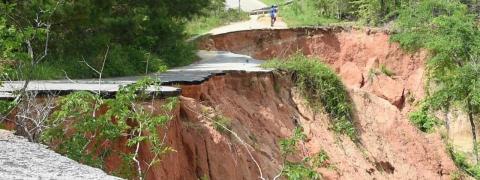Arguably the most severe impacts of climate change on critical infrastructure will be an increase in the frequency and severity of storms, leading to more extreme erosion events. The impacts of erosion hazards are of strategic national importance because they are wide ranging, costly and critical to the vulnerability of assets. Thus creating resilient, sustainable infrastructure depends on understanding the potential future risks of changing erosion hazards and their impact. Decision makers currently face questions about mitigation strategies that are very difficult to answer: (1) Where to act to make an asset more resilient? (2) When action is required: now or can investment be postponed? This project will provide answers to these questions by creating a new computer model to quantify how future climate scenarios will affect severity of erosion hazards in river catchments and the vulnerability of key assets. New risk analyses will be produced to create a novel decision-support tool to provide a coherent robust evidence base for decision making. This approach will ultimately allow stakeholders to assess how they will respond to erosion hazards and enhance their mitigation strategies to provide more benefits for our societies; reducing hazard costs and improving the resilience of critical infrastructure to climate change.
In the UK erosion related hazards cause £336M a year in extra flood damage, are a considerable source of water pollution totalling costs of £238M a year, and increase the costs of water treatment and maintenance of drainage networks by £132M a year. They cause considerable damage to infrastructure such as bridges, flood defences and electricity pylons, and account for 25% of valid subsidence insurance claims. Thus creating resilient, sustainable infrastructure depends on understanding the potential future risks of changing erosion hazards and their impact. Yet at present, no predictive modelling framework exists for erosion hazards, and decision makers currently face questions about mitigation strategies that are very difficult to answer: (1) Where to act to make an asset more resilient? (2) When action is required: now or can investment be postponed?
Project outputs
- Li, X. et al. 2019. A stochastic approach to modelling tidal creek evolution: Exploring environmental influences on creek topologies through ensemble predictions. Geophysical Research Letters. 46, pp. 13836-13844
- Li, X., Cooper, J.R., Plater, A. J. 2021. Quantifying erosion hazards and economic damage to critical infrastructure in river catchments: Impact of a warming climate. Climate Risk Management.
- Erosion Hazards Decision Support Tool
- 21 July 2021: Erosion hazards and economic damage to critical infrastructure in river catchments, with Dr James Cooper.

